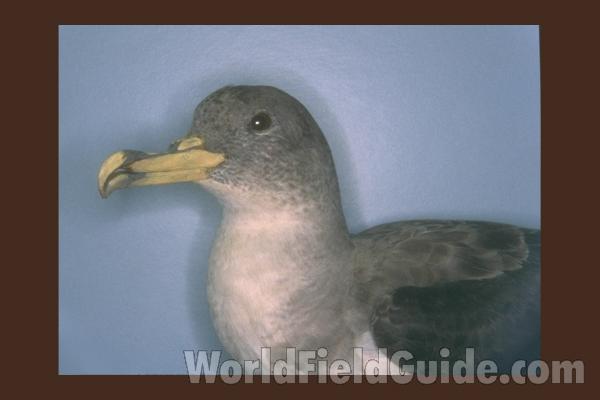SPECIES INFO
Cory's Shearwater (Puffinus diomedea to Calonectris diomedea) is found in the Atlantic Ocean. It can be seen along the Atlantic coast of North America. This shearwater is known to winter in the Mediterranean, but most European birds appear to migrate to the shores of southern Africa. This 19 inch bird is brown dorsally in flight. However, the rounded tail tip is black, and the wing tips and wing edges are also black.
There are two subspecies. The nominate subspecies, Puffinus diomedea diomedea, is found in the Mediterranean. The subspecies borealis breeds in the Atlantic Ocean on the Azores, Canary Islands, and several other groups of Atlantic Ocean Islands.
This bird is on watchlists. It is difficult to estimate populations because of the wide range. However, these estimates range from about 600,000 to about 1,200,000. Fishermen use young birds for fishing bait. Introduced mammals at breeding sites are a problem.The shearwater genus (Puffinus) is found in both the Northern and Southern Hemispheres. Clements in 2007 listed 20 species with two species (P. assimilis and P. lherminieri) showing over 8 subspecies each. In this genus the sexes are very similar with very little variation in color by season. These birds can dive from the surface or from the air. Some species can dive to considerable depths. Shearwaters propel themselves under water with their wings. Shearwaters can also use their mandibles in a skimming manner when in flight to capture fish near the surface. They nest in large colonies in a variety of different habitats at a variety of different elevations.
Many species of shearwaters are on conservation watch lists because of rapidly declining populations. The main problem appears to be introduced mammal predators into their breeding areas. Cats, pigs, and rats are frequently mentioned when one studies individual species and their threats. Commercial fishing and human consumption are also serious problems. Japan, Hawaii, and New Zealand are taking very aggressive legal steps to protect their breeding sites.
Shearwaters and petrels (Family Procellariidae) are medium-large sized birds that fly close to the water. There are 79 species in this family.
Tube Nosed Swimmers (Order Procellariiformes) contains three families of primarily marine birds. There are about 114 different species in this order. The albatrosses, shearwaters, storm petrels, and diving petrels are contained in this order.
Aves contains about 8,650 different species of living birds known to science. Each year about one new species is discovered in some remote rain forest or remote island. In addition, scientists have been raising many subspecies to full species status which may raise the species count to 10,000. Birdlife recognizes 10,027 species as of 2011.
However, each year about one species goes extinct. The rate of extinction is increasing, and the rate of new discovery is decreasing, so that the number of bird species will soon begin to decline rapidly. Although different taxonomists would organize the birds differently, there are approximately twenty-seven orders of birds. These orders are broken down into about one hundred and fifty-five different families.
Recent research of the genetic structure of some of the shore birds and owls would indicate that the present organization of orders and families should have some modification.
The birds are a worldwide group of animals that are characterized by having the front limbs modified into wings that are used for flying. Perhaps the most unique feature of the birds is the feathers. These feathers are made up of a central support called a quill and a series of small filaments that are hooked together as barbs.
For many years it was believed that Archaeopteryx discovered in Bavaria was the oldest bird from about 150 million years ago. However, in l986, Sankar Chattterjee, a Texas paleontologist, reportedly discovered a bird in the genus Protoavis that lived about 225 million years ago.
When this project was begun in 1978, we used Austin & Singer for bird taxonomy. Since then, we have adopted many changes, but have kept some older concepts that are still found widely in the literature. Recently, we have used Clements and Howard & Moore. Very recently, we have used Monroe and Sibley for the higher taxonomy of the perching birds.
Backboned Animals (Phylum Chordata) are the most advanced group of animals on earth. These animals are characterized by having a spinal cord or backbone. Most members have a clearly defined brain that controls the organism through a spinal cord. Fish, amphibians, reptiles, birds, and mammals are in this phylum.
Currently, some taxonomists believe that the fish should be divided into two groups (sharks and regular fishes) and that there are some other primitive groups in the phylum such as hagfish or lampreys.
Animal Kingdom contains numerous organisms that feed on other animals or plants. Included in the animal kingdom are the lower marine invertebrates such as sponges and corals, the jointed legged animals such as insects and spiders, and the backboned animals such as fish, amphibians, reptiles, birds, and mammals.

